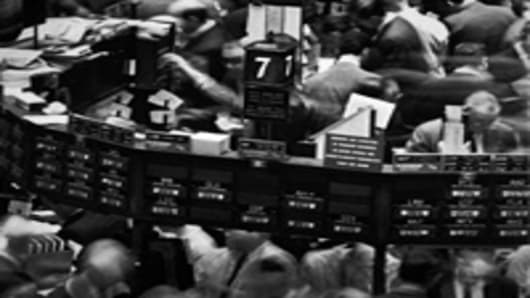Ah, the good old days of, say, 1960. It was pretty simple then: Greg Thompson, an investor from St. Louis, with the Scottrade account, did not have an online account in 1960 (there were none.)
Instead, he called his broker, who then entered the order in their own system, and if it was a stock that traded on the NYSE (and IBM did) it was called onto the floor of the NYSE, where Thompson's order to buy 100 shares was matched with an order to sell 100 shares.
If it was an over-the-counter (OTC) stock, that is, one not listed on the NYSE or AmEx but still traded, the broker called around by phone to market makers who quoted different prices to buy or sell the stock.
Then things began to change.
Timeline: Four Decades of Trading Transformation
1969: The first crack in the wall. Instinet is founded as the first Electronic Communication Network (ECN), which was created to allow brokers to post offers to buy and sell stocks after regular market hours.
The 1970s: Founding of NASDAQ.
1971: The National Association of Securities Dealers, an association of over-the counter (OTC) market makers formed in 1939, created the first electronic stock market: the National Association of Securities Dealers Automated Quotations (NASDAQ) market.
NASDAQ was different from the NYSE in two ways:
- There was no physical floor
- Instead of one market maker (the specialist at the NYSE), there were multiple market makers, often up to a dozen securities dealers who posted offers to buy ("bids") or sell ("ask") stocks over computers.
But this wasn't "electronic trading" in the way we understand it today. Initially, it was just a computerized bulletin board which merely posted bids and offers: prices were updated only once a day! Orders were not matched by computer, they were still taken over the phone well into the mid-1980s.
Still, it did serve to bring down the bid-ask spread and thus help lower the cost of trading.
1975: Fixed commissions are abolished by the SEC. This allowed for the rise of discounted commissions and facilitated the growth of Charles Schwab and others.
1976: NYSE introduces its Designated Order Turnaround \(DOT\) system, which allowed brokers to route 100-share order directly to specialists on the floor. These were not true electronic executions because the specialist still matched the orders, but it did bypass floor brokers.
The 1980s: The rise of electronic trading.
1984: NYSE adopts a more sophisticated SuperDOT system that allows orders up to 100,000 shares to be routed directly to the floor. More floor brokers cut out.
1987: Blame the computers. The 1987 crash is blamed partly on "portfolio insurance" (shorting stock index futures against a stock portfolio).
Electronic trading takes another leap forward as NASDAQ expands the Small Order Execution System (SOES), which allows dealers with small trades to enter their orders electronically rather than over the phone. This was done because during the 1987 crash many broker-dealers simply stopped answering their phones.
Market makers were now required to accept SOES orders, within certain volume and price limitations; this greatly improved the liquidity in many smaller stocks, but was flawed because some traders (SOES bandits) found ways to game the system. Still, it was the death knell for executing most orders by phone.
The 1990s: Erosion of the NYSE specialist business and the rise of online trading.
1996-1999: Online trading begins to explode as Internet traffic dramatically increases. Small traders suddenly had the same access to real-time pricing as professional brokers. The word "day trader" enters the vocabulary.
This became possible because of:
- 1. more powerful personal computers
- 2. higher volume and faster access to bids and offers, which was provided by electronic communication networks (ECNs) like Archipelago and Island
- 3. the growth of online brokerage firms like ETrade, AmeriTrade, and others
- 4. a dramatic drop in commissions which made online trading more profitable
- 5. the bull market in tech stocks which created enormous investor interest.
1997: Stock trading is allowed in increments of one-sixteenth of a dollar, down from one-eighth of a dollar.
New Era of Alogrithms and High-Frequency Trading
The 2000s: Decimilization, algorithmic trading, and high-frequency trading.
2000: The NASD spins off NASDAQ into a publicly traded company.
2001: Stock trading in pennies begins.
The combination of faster technology and going to pennies created big changes:
- 1. It destroyed the profitability of the old system. Once trading went to a penny, it became difficult for specialists and market makers to make money even when committing large amounts of capital. Now you couldn't make a sixteenth of a dollar off a trade, you could only make a penny, so it had to be a big scale business.
- 2. Faster hardware allowed the creation of more sophisticated algorithms that permitted computers to decide the timing, pricing, and quantity of orders based on rules developed by the programmer. Traders could now slice up big orders into hundreds of tiny orders.
- 3. It paved the way for high-frequency trading, a type of trading which employs algorithms but uses those algorithms to make millions of trades a day at very high speeds. Instead of big money on a few trades, they make pennies (or fractions of a penny) on millions of trades.
In the early to mid-2000's, these developments were given a further push by the SEC, which was actively seeking to foster competition. They encouraged electronic trading over traditional, floor-based trading and created a new regulatory structure to foster that goal.
2001: NYSE introduces Direct+, which provided immediate automatic execution of limit orders up to 1,099 shares. This is real electronic trading (automated matching of buy and sell orders) and was the beginning of the end of the old floor specialist system.
2005: Reg-NMS changes everything. The SEC consolidates all rules on the national market system into Reg-NMS, which forced the NYSE to go electronic and fostered the growth of competing ECNs and exchanges.
The key tenet was the trade-through rule, which required all participants to respect the best bid and offer wherever it was. This meant that no exchange could "trade-through" (execute an order at an inferior price). The effect: the NYSE floor system, which was a "slow" system, had difficulty competing against the "faster" electronic marketplaces, which sometimes offered better bids and offers.
In response, NYSE launches NYSE Hybrid in December, which attempts to combine the NYSE floor operations with electronic trading occurring off the floor. The 1,099 share limits on the Direct+ system were removed. Specialist participation in the marketplace begins dropping drastically.
2006: NYSE demutualizes, becomes a for-profit, publicly traded company. This gives the exchanges an incentive to start managing for profit and the brokers incentive to start more competition.
NYSE buys Archipelago, an all-electronic trading platform, and renames it NYSE Arca.
2007: NYSE merges with Euronext, which had been formed in 2000 through the merger of the Amsterdam, Brussels, and Paris exchanges.
2008: NYSE eliminates specialists, renaming them Designated Market Makers, though still in charge of maintaining a fair and orderly market in their stocks.
NASDAQ completes its acquisition of the Boston Stock Exchange and the Philadelphia Stock Exchange.
BATS, formerly an ECN, becomes an exchange.
2010: Direct Edge, formerly an ECN, becomes an exchange.
Bottom line: Technology + Competition = Big Changes.
The biggest change of all is who is doing the trading. It's been estimated that 60 percent of the volume is now done by high-frequency traders. What are they? Who are they?





